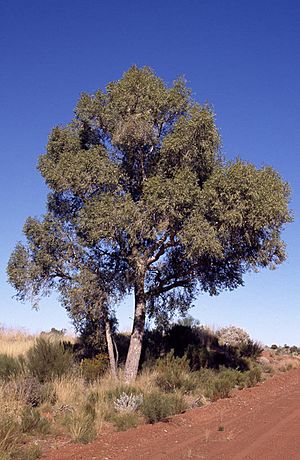Sand-dune bloodwood facts for kids
Quick facts for kids Sand-dune bloodwood |
|
|---|---|
 |
|
| Eucalyptus chippendalei near Warburton | |
| Scientific classification | |
| Genus: |
Corymbia
|
| Species: |
chippendalei
|
| Synonyms | |
|
Eucalyptus chippendalei D.J.Carr & S.G.M.Carr |
|
Corymbia chippendalei, commonly known as the sand-dune bloodwood or sandhill bloodwood, is a species of small tree or a mallee that is endemic to desert country in central Australia. It has rough bark on part or all of the trunk, lance-shaped adult leaves, flower buds in groups of seven, white flowers and shortened spherical fruit.
Descrtiption
Eucalyptus chippendalei is a tree that typically grows to a height of 10 m (33 ft), sometimes a smaller mallee, and forms a lignotuber. It has rough, flaky or tessellated bark on part or all of the trunk, smooth cream-coloured or white bark above. Young plants and coppice regrowth have lance-shaped to narrow lance-shaped leaves that are 50–110 mm (2.0–4.3 in) long, 10–20 mm (0.39–0.79 in) wide and more or less sessile. Adult leaves are the same shade of glossy green on both sides, 80–130 mm (3.1–5.1 in) long and 10–23 mm (0.39–0.91 in) wide tapering to a petiole 10–20 mm (0.39–0.79 in) long. The flower buds are arranged on the ends of branchlets on a branched peduncle 5–20 mm (0.20–0.79 in) long, each branch of the peduncle with seven buds on pedicels 1–7 mm (0.039–0.276 in) long. Mature buds are oval to pear-shaped, 7–9 mm (0.28–0.35 in) long and 5–7 mm (0.20–0.28 in) wide with a rounded to conical operculum. Flowering occurs from January to March and the flowers are white. The fruit is a woody, shortened spherical capsule 16–28 mm (0.63–1.10 in) long and 15–250 mm (0.59–9.84 in) wide with the valves enclosed in the fruit.
Taxonomy and naming
The sand-dune bloodwood was first formally described in 1985 by Denis Carr and Stella Carr and was given the name Eucalyptus chippendalei. In 1995 Ken Hill and Lawrie Johnson changed the name to Corymbia chippendalei. The specific epithet (chippendalei) honours George Chippendale.
Distribution and habitat
Corymbia chippendalei usually grows on the crest of sand dunes in the Great Sandy Desert and central ranges of far eastern Western Australia, and in the south-west of the Northern Territory.

